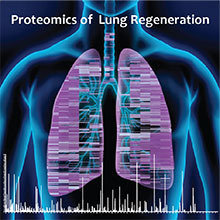How the lung repairs its wounds

According to the World Health Organization (WHO), lung diseases are the third most common cause of death worldwide: toxic particles, infections, and chronic inflammatory responses pose a permanent threat to our lungs. To date, the regenerative mechanisms leading to healing of lung injury remain incompletely understood. Since few to no causal therapies are in place for most lung diseases, it is important to understand how these healing processes, which involve initial inflammation, fibrosis, and then resolution thereof, occur in the lung.
Using novel mass spectrometry techniques, an interdisciplinary team of scientists led by Matthias Mann, Director at the MPI of Biochemistry, and Oliver Eickelberg, Chairman of the Comprehensive Pneumology Center (CPC) at the Helmholtz Zentrum München and University Hospital of the Ludwig-Maximilians-Universität, has now succeeded, for the first time, to quantify and profile dynamic changes in the composition of the lung tissue throughout the different phases of lung regeneration.
More than 8,000 proteins examined
When the pulmonary alveoli are damaged, various proteins are secreted into the extracellular space, where they form the so-called extracellular matrix (ECM). These proteins are crucial for tissue healing by instructing various processes, including the activation of specific stem cell populations, ensuring that lung tissue can be restored to its original condition. Now, the scientists succeeded for the first time in identifying and quantifying the abundance and solubility of more than 8,000 proteins in the lung proteome throughout the multistage tissue repair processes. “The information we have gained about the dynamic changes in ECM composition and its interactions with various secreted growth factor proteins enables us to develop new hypotheses for the activation of stem cells in the lung,” explains Herbert Schiller, first author of the study.
The findings of the research team will provide an important basis for further translational research on the development of pulmonary fibrosis* and chronic lung diseases in general, the scientists say. “These novel mass spectrometry techniques enable us to analyze variations in the type and abundance of proteins in patients with lung fibrosis and healthy individuals and will therefore likely lead to new approaches for the treatment of chronic lung diseases in general and lung fibrosis in particular,” Eickelberg predicts.
Background:
* Pulmonary fibrosis is a chronic lung disease, characterized by pathological accumulation of ECM proteins, which results in hardening of the lung and thus difficulties to breathe. The development of fibrosis is believed to be a result of defective regeneration mechanisms.
Original publication:
H.B. Schiller, I.E. Fernandez, G. Burgstaller, C. Schaab, R.A. Scheltema, T. Schwarzmayr, T.M. Strom, O. Eickelberg and M. Mann: Time- and compartment-resolved proteome profiling of the extracellular niche in lung injury and repair. EMBO Molecular Systems Biology, July 14, 2015
DOI: 10.15252/msb.20156123












